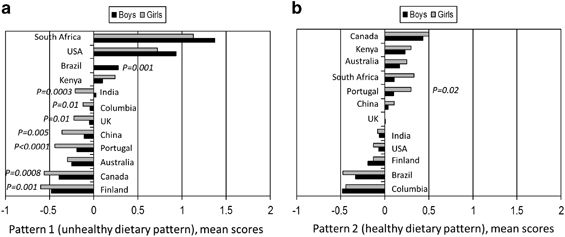International Journal of Obesity Supplements Pub Date : 2015-12-08 , DOI: 10.1038/ijosup.2015.14 V Mikkilä 1 , H Vepsäläinen 1 , T Saloheimo 1 , S A Gonzalez 2 , J D Meisel 3 , G Hu 4 , C M Champagne 4 , J-P Chaput 5 , T S Church 4 , P T Katzmarzyk 4 , R Kuriyan 6 , A Kurpad 6 , E V Lambert 7 , C Maher 8 , J Maia 9 , V Matsudo 10 , T Olds 8 , V Onywera 11 , O L Sarmiento 2 , M Standage 12 , M S Tremblay 5 , C Tudor-Locke 13 , P Zhao 14 , M Fogelholm 1 ,

|
OBJECTIVES:
Dietary pattern is defined as a combination of foods and drinks and the frequency of consumption within a population. Dietary patterns are changing on a global level, which may be linked to an increased incidence of chronic diseases. The aim of this study was to identify and compare the dietary patterns among 9–11-year-old children living in urban regions in different parts of the world.
METHODS:
Participants were 7199 children (54% girls), aged 9–11 years, from 12 countries situated in all major world regions. Food consumption was assessed using a 23-item Food Frequency Questionnaire (FFQ). To identify dietary patterns, principal components analyses (PCA) were carried out using weekly portions as input variables.
RESULTS:
Both site-specific and pooled PCA resulted in two strong components. Component 1 (‘unhealthy diet pattern’) included fast foods, ice cream, fried food, French fries, potato chips, cakes and sugar-sweetened sodas with >0.6 loadings. The loadings for component 2 (‘healthy diet pattern’) were slightly weaker with only dark-green vegetables, orange vegetables, vegetables in general, and fruits and berries reaching a >0.6 loading. The site-specific diet pattern scores had very strong correlations with the pattern scores from the pooled data: r=0.82 and 0.94 for components 1 and 2, respectively.
CONCULSIONS:
The results suggest that the same ‘healthier’ and ‘unhealthier’ foods tend to be consumed in similar combinations among 9–11-year-old children in different countries, despite variation in food culture, geographical location, ethnic background and economic development.
中文翻译:

9-11 岁儿童饮食模式的国际比较
目标:
饮食模式被定义为食物和饮料的组合以及人群中的消费频率。饮食模式在全球范围内正在发生变化,这可能与慢性病发病率增加有关。本研究的目的是确定和比较世界不同地区生活在城市地区的 9-11 岁儿童的饮食模式。
方法:
参与者是来自世界所有主要地区的 12 个国家的 7199 名儿童(54% 为女孩),年龄在 9-11 岁之间。使用 23 项食物频率问卷 (FFQ) 评估食物消耗。为了确定饮食模式,使用每周部分作为输入变量进行主成分分析(PCA)。
结果:
特定站点和合并 PCA 都产生了两个强大的组件。成分 1(“不健康的饮食模式”)包括快餐、冰淇淋、油炸食品、炸薯条、薯片、蛋糕和含糖量 >0.6 的加糖苏打水。成分 2(“健康饮食模式”)的负荷稍弱,只有深绿色蔬菜、橙色蔬菜、一般蔬菜以及水果和浆果的负荷达到 >0.6。特定地点的饮食模式得分与汇总数据的模式得分有很强的相关性:成分 1 和 2 的r = 0.82 和 0.94,分别。
结论:
结果表明,尽管饮食文化、地理位置、种族背景和经济发展存在差异,但不同国家的 9-11 岁儿童倾向于以相似的组合食用相同的“更健康”和“不健康”食物。











































 京公网安备 11010802027423号
京公网安备 11010802027423号